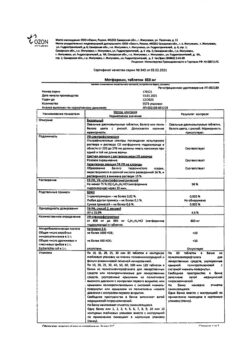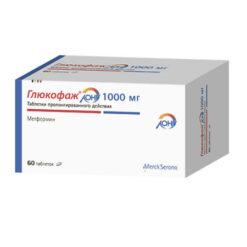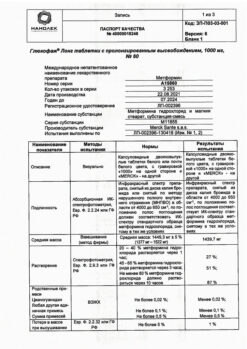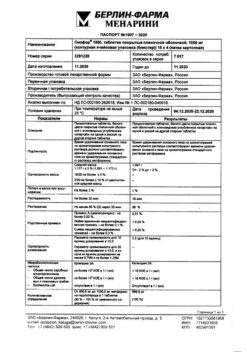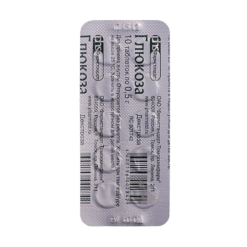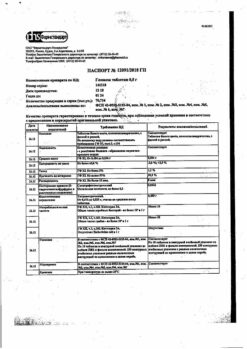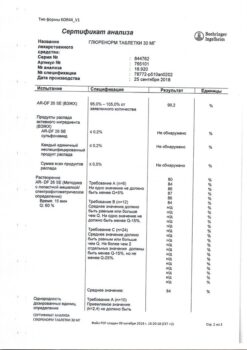No products in the cart.
Metformin, tablets 500 mg 60 pcs
€3.32 €3.02
Description
Pharmacotherapeutic group
Hypoglycemic drug of oral biguanide group
ATC code
A10BA02
Pharmacological action
Metformin reduces hyperglycemia without causing hypoglycemia. Unlike sulfonylurea derivatives, it does not stimulate insulin secretion and has no hypoglycemic effect in healthy individuals. Increases peripheral receptor sensitivity to insulin and glucose utilization by cells. Inhibits gluconeogenesis in the liver. Delays absorption of carbohydrates in the intestine. Metformin stimulates glycogen synthesis by acting on glycogen synthase. Increases the transport capacity of all types of membrane glucose transporters. In addition, it has a favorable effect on lipid metabolism: it reduces total cholesterol, low-density lipoproteins and triglycerides. Against the background of taking metformin, the patient’s body weight either remains stable or decreases moderately.
Indications
Indications
Type 2 diabetes mellitus, especially in obese patients, with ineffective diet therapy and exercise: in adults as monotherapy or in combination with other oral hypoglycemic agents, or with insulin; in children over 10 years of age as monotherapy or in combination with insulin.
Pharmacological effect
Pharmacological effect
Pharmacotherapeutic group
Hypoglycemic agent of the biguanide group for oral use
ATX code
A10BA02
Pharmacological action
Metformin reduces hyperglycemia without leading to the development of hypoglycemia. Unlike sulfonylurea derivatives, it does not stimulate insulin secretion and does not have a hypoglycemic effect in healthy individuals. Increases the sensitivity of peripheral receptors to insulin and the utilization of glucose by cells. Inhibits gluconeogenesis in the liver. Delays the absorption of carbohydrates in the intestines. Metformin stimulates glycogen synthesis by acting on glycogen synthase. Increases the transport capacity of all types of membrane glucose transporters. In addition, it has a beneficial effect on lipid metabolism: it reduces the content of total cholesterol, low-density lipoproteins and triglycerides. While taking metformin, the patient’s body weight either remains stable or decreases moderately.
Special instructions
Special instructions
Lactic acidosis
Lactic acidosis is a rare but serious (high mortality in the absence of immediate treatment) complication that can occur due to the accumulation of metformin. Cases of lactic acidosis when taking metformin occurred mainly in patients with diabetes mellitus with severe renal failure.
Other associated risk factors should be taken into account, such as decompensated diabetes mellitus, ketosis, prolonged fasting, alcoholism, liver failure and any condition associated with severe hypoxia. This may help reduce the incidence of lactic acidosis. The risk of developing lactic acidosis should be taken into account when nonspecific signs appear, such as muscle cramps accompanied by dyspeptic disorders, abdominal pain and severe asthenia. Lactic acidosis is characterized by acidotic shortness of breath, abdominal pain and hypothermia followed by coma. Diagnostic laboratory indicators are a decrease in blood pH (less than 725) containing lactate in the blood plasma over 5 mmol/l, increased anion gap and lactate/pyruvate ratio. If metabolic acidosis is suspected, stop taking the drug and consult a doctor immediately.
Surgical operations
The use of metformin should be discontinued 48 hours before elective surgery and can be continued no earlier than 48 hours after, provided that renal function has been found to be normal during the examination.
Kidney function
Since metformin is excreted by the kidneys before starting treatment and regularly thereafter, it is necessary to determine creatinine clearance:
at least once a year in patients with normal renal function;
at least 2-4 times a year in elderly patients and also in patients with creatinine clearance at the lower limit of normal.
In case of creatinine clearance less than 45 ml/min, the use of the drug is contraindicated. Particular caution should be exercised in case of possible impairment of renal function in elderly patients while using antihypertensive drugs, diuretics or non-steroidal anti-inflammatory drugs.
Heart failure
Patients with heart failure have a higher risk of developing hypoxia and renal failure. Patients with chronic heart failure should have cardiac and renal function monitored regularly while taking metformin. Taking metformin in heart failure with unstable hemodynamic parameters is contraindicated.
Children and teenagers
Clinical experience with the use of metformin in children aged 10 to 12 years is limited; therefore, the most careful monitoring is necessary in children in this age group. The diagnosis of type 2 diabetes mellitus must be confirmed before starting treatment with metformin. In clinical studies lasting 1 year, metformin was shown to have no effect on growth and puberty. However, due to the lack of long-term data, careful monitoring of the subsequent effects of metformin on these parameters in children is recommended, especially during puberty.
Other Precautions
Patients are advised to continue to follow a diet with even carbohydrate intake throughout the day. Overweight patients are advised to continue to follow a hypocaloric diet (but not less than 1000 kcal/day).
It is recommended that routine laboratory tests be performed regularly to monitor diabetes mellitus.
Metformin in monotherapy does not cause hypoglycemia; however, it is recommended to exercise caution when using it in combination with insulin or other hypoglycemic agents (for example, sulfonylurea derivatives repaglinide, etc.).
The use of the drug in patients with prediabetes is recommended in the presence of additional risk factors for the development of overt type 2 diabetes mellitus, which include:
age less than 60 years;
body mass index (BMI) >30 kg/m2;
history of gestational diabetes mellitus;
family history of diabetes mellitus in first-degree relatives;
increased concentration of triglycerides;
reduced concentration of HDL cholesterol;
arterial hypertension.
Metformin did not affect fertility in male or female rats when administered at doses three times the maximum recommended daily dose for humans.
Impact on the ability to drive vehicles. Wed and fur.:
Monotherapy with the drug does not cause hypoglycemia and therefore does not affect the ability to drive vehicles and machines. Patients should be warned about the risk of developing hypoglycemia when using metformin in combination with other hypoglycemic drugs (sulfonylurea derivatives, repaglinide, insulin, etc.), which impair the ability to drive vehicles and engage in other potentially hazardous activities that require increased attention and rapid psychomotor reactions.
Active ingredient
Active ingredient
Metformin
Composition
Composition
One 500 mg tablet contains:
active substance: metformin hydrochloride – 500 mg.
excipients: microcrystalline cellulose, croscarmellose sodium, purified water, povidone (polyvinylpyrrolidone), magnesium stearate.
Contraindications
Contraindications
Hypersensitivity to metformin or to any excipient; diabetic ketoacidosis, diabetic precoma, coma; renal failure or impaired renal function (creatinine clearance (CC) less than 60 ml/min); acute conditions that occur with a risk of developing renal dysfunction: dehydration (with diarrhea, vomiting), severe infectious diseases, shock; clinically pronounced manifestations of acute or chronic diseases that can lead to the development of tissue hypoxia (including cardiac or respiratory failure, acute myocardial infarction); extensive surgical operations and injuries when insulin therapy is indicated; liver failure, liver dysfunction; chronic alcoholism, acute alcohol poisoning; pregnancy; lactic acidosis (including history); use within less than 48 hours before and within 48 hours after radioisotope or x-ray studies with the introduction of an iodinated contrast agent; following a low-calorie diet (less than 1000 kcal/day); children under 10 years of age.
Side Effects
Side Effects
The frequency of side effects of the drug is assessed as follows: very often: > 1/10; often: 1/10-1/100; uncommon: 1/100-1/1000; rare: 1/1000-1/10000; very rare: < 1/10000.
Metabolic and nutritional disorders
Very rare: lactic acidosis (see section “Special instructions”).
With long-term use of metformin, a decrease in the absorption of vitamin B12 may be observed. When megaloblastic anemia is detected, the possibility of such an etiology must be taken into account.
Nervous system disorders
Common: taste disturbance.
Gastrointestinal disorders
Very common: nausea, vomiting, diarrhea, lack of appetite, abdominal pain.
These side effects often occur during the initial period of treatment and in most cases, they disappear spontaneously with continued use. To reduce side effects, it is recommended to take the drug during or after meals. Slowly increasing the dose may improve gastrointestinal tolerability.
Disorders of the liver and biliary tract
Very rare: abnormal liver function tests and hepatitis. After discontinuation of metformin, these adverse effects completely disappear.
Skin and subcutaneous tissue disorders
Very rare: skin reactions such as erythema, itching, rash.
Published post-marketing data as well as controlled clinical studies in a limited pediatric population in the age group of 10-16 years indicate that side effects in children are similar in nature and severity to those in adult patients.
Storage conditions
Storage conditions
Store at a temperature not exceeding 25 °C.
Keep out of the reach of children.
Shelf life
Shelf life
3 years.
Do not use after the expiration date indicated on the package.
Manufacturer
Manufacturer
Ozon, Russia
Additional information
| Shelf life | 3 years. Do not use after the expiration date stated on the package. |
|---|---|
| Conditions of storage | Store at the temperature not more than 25 °С. Keep out of reach of children. |
| Manufacturer | Ozon, Russia |
| Medication form | pills |
| Brand | Ozon |
Other forms…
Related products
Buy Metformin, tablets 500 mg 60 pcs with delivery to USA, UK, Europe and over 120 other countries.



